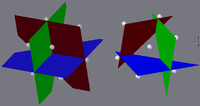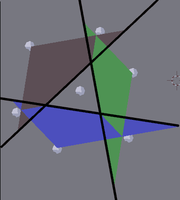Hi, everyone! I got this problem I've been stuck with.
N places are located in space such that no 2 are parallel, every 3 cross at exactly 1 point, no 4 cross at the same point.
1. In how many parts do those N planes cut the space?
2. What the formula would be like for (k-1) hyperplanes in R^k space?
I solved a similar problem for lines in 2d space (no two lines are parallel and no 3 intersect at 1 point) Every new line divides the space in n+1 new pieces, so the formula I got is: number of pieces= 1+n(n+1)/2.
How can I apply the same logic for question 1? Having a hard time to imagine all those planes, I created a table:
number of planes 0 1 2 3 4
pieces of space 1 2 4 6 10
Am I doing it right? How could I progress? Any tips?
N places are located in space such that no 2 are parallel, every 3 cross at exactly 1 point, no 4 cross at the same point.
1. In how many parts do those N planes cut the space?
2. What the formula would be like for (k-1) hyperplanes in R^k space?
I solved a similar problem for lines in 2d space (no two lines are parallel and no 3 intersect at 1 point) Every new line divides the space in n+1 new pieces, so the formula I got is: number of pieces= 1+n(n+1)/2.
How can I apply the same logic for question 1? Having a hard time to imagine all those planes, I created a table:
number of planes 0 1 2 3 4
pieces of space 1 2 4 6 10
Am I doing it right? How could I progress? Any tips?



